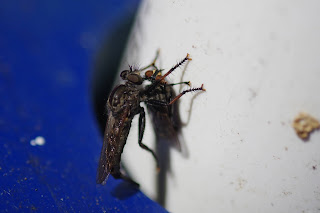Backyard Co-Bug of the Day #1:
This is either a viceroy or a red spotted purple caterpillar. They are closely related, and apparently sometimes even interbreed, and their caterpillars look very similar. I can't go by host plant, because they don't pupate on their host plant, they crawl away to pupate somewhere else (this is on a goldenrod plant).
So, my only chance to figure out what kind of butterfly this will become is if I happen to see it emerge from its chrysalis. What chrysalis, you ask?
This one:
I showed the caterpillar to my husband before we went on our woods walk. I checked on it when we came back, because I had a feeling it would not be a caterpillar anymore, and I was right; it had become a chrysalis. It's cool that the chrysalis shows the shape of the wing and the antennae.
Backyard Co-Bug of the Day #2:
A new species for me, I think. Some kind of leaf hopper or plant hopper; I could not find it in my books.
Other Bugs:
Earwig. I think this is a female. You can tell the difference between females and males by the size of the pincher-like bits on the back end. The problem is that it is a comparative thing, and it's hard to compare when you see only one. But these look small to me, which would mean it's a female.
Caterpillar in a silk tent
Camouflaged looper caterpillar.
Lately caterpillars are much more prevalent in the backyard. I have been wondering where they all are.
Side view of the hooktip rose caterpillar, which had moved to a new leaf.
Monarch caterpillars:
I could only find one of the two from yesterday, but...
I think I was wrong that the monarch egg that disappeared last week had been eaten. I think it hatched, and this is the caterpillar that emerged from it. Anyway, it was on one of the plants that may have been where the egg was. It's a bit hard to keep track, really. However, if this is the caterpillar, then technically the egg was eaten; the first thing monarch caterpillars do after they hatch is eat their egg case.
Thorn mimic planthopper
I was standing next to the picnic table, watching the insect activity in the milkweed patch, when something buzzed past me and I looked in time to see this crash into the umbrella holder on the picnic table:
A robber fly with another fly as prey. I don't know what it was trying to do, but it smacked right into this pole and lay there for about thirty seconds.
Eventually it righted itself, crawled up the post a bit, and then flew away, carrying its prey.
Katydid nymph
Red milkweed beetle. Finally! I have been wondering about the lack of the various milkweed-specific species of insects, like milkweed beetles and milkweed bugs.
There were several thick-headed flies on the milkweed today:
And I finally got pictures of them flying!
Taking a picture of a plume moth and a weevil...
I was photobombed by a couple of bumblebees. I had made a decision not to take pictures of bumblebees on milkweed today, and they obviously were resentful about being left out.
Better look at the weevil
I found another leaf with a lot of lace bugs, with three adult lace bugs. Two of the adults are working on propagating the species. I think the other adult is hoping to have a chance to make a genetic contribution to future generations.
There are a lot of nymphs left on this leaf. On the other leaves I have been observing, the nymphs are all gone.
I have been finding a lot of hopper nymphs, too:
Dragonfly
The stinkbug nymphs are still hanging out near their egg mass. Some of the other eggs look empty, but not like they have been hatched. It's obvious that these two have grown in the time I have been observing them.
Tree louse:
I think this is an ichneumon wasp:
It was digging a hole in the ground. It had not gotten very far, maybe only a half inch. I should have gone to check on it later; maybe I will remember to do that tomorrow.
White flies
Arachnid Appreciation:
.
.
.
.
.
.
.
.
.
.
.
.
I almost walked face-first into this web. This is a popular height for spider webs; in the woods I walk through them a lot, though usually those are just single strands across a path, not orb webs like this.







































No comments:
Post a Comment